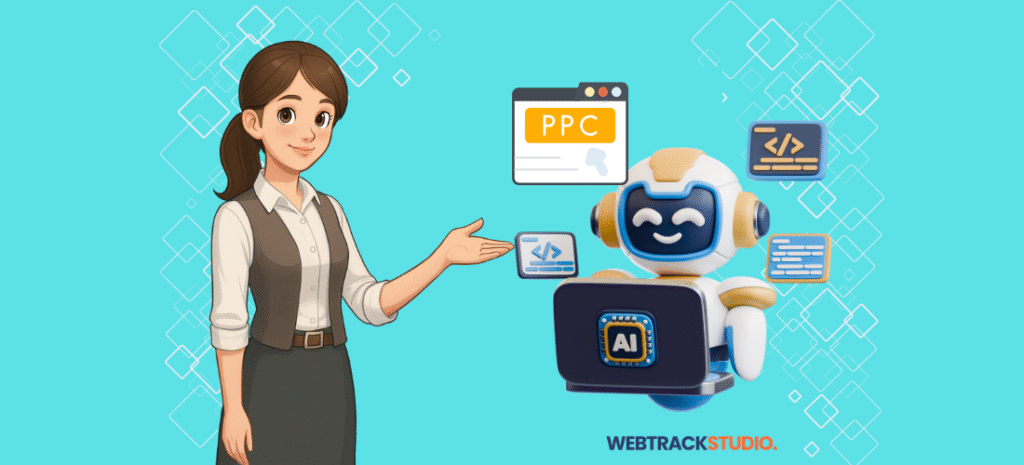Table of Contents
- What Are LLMs, and Why Do They Matter for PPC?
- Traditional PPC vs. AI-Driven PPC: The Performance Gap
- How Fine-Tuned LLMs Improve Ad Relevance and Click-Through Rates
- Understanding Search Intent and Semantic Targeting
- Step-by-Step: How to Fine-Tune an LLM for Your Campaigns
- Integrating LLM Outputs with Major Ad Platforms
- LLM Tools for PPC Optimization
- Brand Safety, Compliance, and Ethical Considerations
- Human-AI Collaboration: The Optimal Workflow
- Latest Updates: New LLM Features Every Marketer Should Know
- The Most Common Mistakes to Avoid When Using LLMs for PPC
- FAQs—Your Top Questions Answered
- Conclusion
Are you struggling to get more clicks and conversions from your PPC ads? You’re not alone.
Managing successful PPC campaigns used to be simple. Pick the right keywords, set your budget, and hope for results. But that approach no longer works. Rising competition and changing ad platforms have made manual PPC management difficult.
To stand out today, you need smarter technology. The future of pay-per-click advertising isn’t just about bidding strategies. It’s about the message. Large language models (LLMs) change everything here.
Instead of spending weeks testing ad copy manually, you can use LLMs to generate hyper-personalized ads instantly. These ads speak directly to your audience.

What Are LLMs, and Why Do They Matter for PPC?
Large language models are AI systems that read, understand, and write text like humans. Think of them as super-smart assistants. They can create everything from emails to ad headlines in seconds.
Here’s why they matter for PPC:
- They analyze massive amounts of data quickly
- They generate ad copy tailored to specific keywords and audiences
- They make personalization effortless
- They save hours of A/B testing time
- They improve relevance, click-through rates, and overall performance
The personalization that used to take days? LLMs deliver it in minutes.
Traditional PPC vs. AI-Driven PPC: The Performance Gap
The difference between traditional and AI-enhanced PPC is significant. Traditional approaches rely on manual ad creation. They offer limited personalization. The messaging often feels generic and fails to stand out.
Traditional PPC Approach:
- Manual ad copy creation (hours per campaign)
- Limited A/B testing (3-5 versions typically)
- Generic messaging across all segments
- Weeks to find winning combinations
- Reactive optimization based on delayed data
AI-Driven PPC with Fine-Tuned LLMs:
- Automated ad generation (minutes per campaign)
- Hundreds of variations tested at once
- Hyper-personalized messaging for each segment
- Real-time performance insights
- Proactive optimization using predictive data
The results speak for themselves. Marketers using fine-tuned LLMs report impressive gains:
- 35-60% average improvement in click-through rates
- 20-40% reduction in cost per acquisition (CPA)
- 2-3x increases in return on ad spend (ROAS)
How Fine-Tuned LLMs Improve Ad Relevance and Click-Through Rates
Fine-tuned models write ads that resonate with your specific audience. They learn the language your customers use, the challenges they face, and the solutions they value most. The result is ad copy that aligns with audience expectations and speaks directly to their needs.
The Impact on Key Performance Metrics
Fine-tuned LLMs directly influence the metrics that matter most:
- Click-Through Rate (CTR): Improves by 40-65% through emotionally resonant headlines
- Quality Score: Jumps from 5-6 to 8-9, lowering cost per click by 30-50%
- Conversion Rate: Increases by 25-45% through better ad-to-landing page alignment
- Cost Per Acquisition (CPA): Reduces by 30-55%
- Return on Ad Spend (ROAS): Doubles or triples, with some campaigns seeing 5x improvements
Understanding Search Intent and Semantic Targeting
Fine-tuned LLMs excel at understanding and matching search intent. Traditional keyword matching often misses important nuances. It doesn’t capture what users actually want.
Semantic Keyword Clustering
LLMs can analyze thousands of keywords at once. They group them by semantic meaning, not just text similarity.
Consider these searches. They have different intents despite keyword overlap:
- “best running shoes for beginners” (Informational)
- “buy Nike running shoes online” (Transactional)
- “running shoes vs. training shoes” (Comparison)
- “cheap running shoes near me” (Local Purchase)
A fine-tuned LLM creates unique ad copy for each intent:
For informational intent: “New to Running? Find Your Perfect First Pair With Our Beginner’s Guide”
For transactional intent: “Nike Running Shoes – Free Shipping & 60-Day Returns. Shop Now”
For comparison intent: “Running vs Training Shoes: Expert Comparison + Top Picks for 2025”
This semantic targeting ensures your ad message matches exactly what users seek. It dramatically improves engagement and Quality Score.
Audience Insight Mining
Fine-tuned LLMs excel at extracting insights from customer data. They can analyze:
- Customer reviews and testimonials
- Support ticket conversations
- Social media comments
- Survey responses
- Competitor messaging
The model identifies the exact language your audience uses. It uncovers their concerns and motivations. This goes far beyond demographics. It captures psychographic patterns that drive purchasing decisions.
Step-by-Step: How to Fine-Tune an LLM for Your Campaigns
| Step | What You Do | Best Practices |
|---|---|---|
| Gather Data | Collect high-performing ads, testimonials, and competitor info. | Aim for 500–2,000 examples. Include CTR & conversion data. |
| Clean Data | Organize and remove irrelevant or duplicate entries. | Keep only strong examples. Maintain consistent formatting. |
| Choose Model | Select a base LLM (GPT, LLaMA, Cohere, etc.). | Consider budget, token limits, and commercial licensing. |
| Train Model | Feed your data to adjust tone and brand voice. | Use validation sets and track model loss during training. |
| Test & Refine | Generate ad copy, A/B test, and optimize results. | Iterate using CTR and Quality Score data. |
Data Requirements and Quality Standards
Minimum Training Data: You need 300-500 high-quality examples for basic fine-tuning. However, 1,000-2,000 examples yield significantly better results.
Data Format: Structure your training data as prompt-completion pairs:
Prompt: “Write a Google Search ad for ‘organic coffee beans’ targeting health-conscious millennials”
Completion: “Headline: Pure Organic Coffee – No Chemicals, Just Flavor
Description: USDA Certified Organic Beans. Small-Batch Roasted. Support Sustainable Farms.”
Essential Metadata: Include performance data with each example. Add CTR, conversion rate, and Quality Score. This lets you weight high-performers during training.
Integrating LLM Outputs with Major Ad Platforms
Creating great ad copy is only half the battle. You need seamless integration with your advertising platforms.
Google Ads Integration
Use the Google Ads API to upload ad variations programmatically. This allows you to:
- Create dozens of Responsive Search Ads with varied combinations
- Automatically populate Performance Max campaigns with assets
- Update underperforming ads based on real-time quality data
Fine-tune your model with character constraints: headlines at 30 characters or less, descriptions at 90 characters or less. Train it on Google’s advertising policies to avoid violations like unsupported superlatives, prohibited content, and trademark issues.
Meta (Facebook/Instagram) Ads Integration
Meta’s Advantage+ campaigns benefit from LLM-generated variations. Generate 10-20 variations of each element (primary text, headline, description). Let Meta’s algorithm find optimal combinations for different audience segments.
Use the Meta Marketing API to create ad sets programmatically with your LLM-generated copy.
Microsoft Advertising and LinkedIn Ads
Similar integration opportunities exist across platforms. The key is using each platform’s API. This automates the upload and testing process. Ensure your fine-tuned model respects each platform’s unique requirements and character limits.
LLM Tools for PPC Optimization
1. Ad Copy Generation & Personalization
- OpenAI (ChatGPT / GPT-4/5 API) → Generate multiple ad variations fast → https://openai.com/
- Copy.ai → Marketing-focused tool for ad headlines & descriptions → https://www.copy.ai/
- Jasper → AI writing assistant tailored for ads and content → https://www.jasper.ai/
- Writesonic → Specialized in PPC, Google Ads, and social ad copy → https://writesonic.com/
2. Audience & Keyword Insights
- Cohere → Embeddings for clustering keywords & customer segments → https://cohere.com/
- Google Cloud Vertex AI → Connect LLMs with Google Ads data → https://cloud.google.com/vertex-ai
- LlamaIndex → Build RAG pipelines to feed real-time data into campaigns → https://www.llamaindex.ai/
3. Campaign Optimization & Automation
- LangChain → Automate workflows like ad testing & reporting → https://www.langchain.com/
- Zapier AI + OpenAI → Trigger new ad copy when performance dips → https://zapier.com/ai
- HubSpot AI Ads Add-on → AI-powered ad optimization → https://www.hubspot.com/artificial-intelligence
4. Fine-Tuning for Brand Voice
- Hugging Face (PEFT/LoRA) → Fine-tune LLMs for custom tone & compliance → https://huggingface.co/
- Weights & Biases (W&B) → Track experiments & manage ad-focused fine-tuning → https://wandb.ai/
Brand Safety, Compliance, and Ethical Considerations
LLMs offer tremendous advantages. However, responsible implementation requires attention to safety and ethics.
Brand Safety Protocols
Tone Consistency: Fine-tuning helps maintain brand voice. However, always implement human review before ads go live. Even well-trained models can occasionally produce off-brand messaging.
Prohibited Content Filters: Configure your LLM with explicit filters for:
- Superlative claims without substantiation
- Prohibited products or services
- Trademark violations
- Discriminatory language
- Misleading promises
Data Privacy and Customer Information
Training Data Hygiene: Never include personally identifiable information (PII) in your training datasets. Strip customer names, email addresses, and phone numbers. Remove all other sensitive data before fine-tuning.
GDPR and CCPA Compliance: You may use customer data to inform ad copy. If so, ensure you have proper consent. Maintain data processing agreements.
Third-Party AI Service Agreements: Review the terms of service for any LLM provider you use. Understand how your training data is used and stored. Know whether it might be used to improve the base model.
Transparency and Disclosure
You’re not legally required to disclose that AI wrote your ads. However, transparency builds trust. Some brands add subtle indicators. They might note “AI-optimized campaign” in internal documentation. This isn’t customer-facing.
Human-AI Collaboration: The Optimal Workflow
The best results come from combining AI efficiency with human creativity and judgment.
The Ideal Division of Labor
AI Handles:
- Generating initial draft variations (10-50+ options)
- Identifying semantic patterns in high-performing ads
- Analyzing competitor messaging at scale
- Adapting copy for different audience segments
- Real-time performance monitoring
- Flagging underperformers
Humans Handle:
- Strategic campaign direction and goals
- Final approval of all ad copy before launch
- Brand voice refinement and edge case judgment
- Creative concepts requiring deep cultural understanding
- Compliance verification and risk assessment
- Responding to unexpected performance anomalies
Establishing a Review Process
Tier 1 – Automated Approval: Some ads can launch with minimal review. These score above 85% similarity to proven winners. They must also pass automated policy checks.
Tier 2 – Quick Human Review: Some ads need brief human review. These include new messaging angles or new segments. They get a 5-minute review for brand alignment.
Tier 3 – Full Creative Review: Major campaigns need comprehensive review. So do sensitive products and entirely new messaging strategies. These receive full creative team review.
This tiered approach lets you scale efficiently. It maintains quality and brand integrity.
Latest Updates: New LLM Features Every Marketer Should Know
Modern LLMs now come with multi-modal capabilities. This means they can analyze images and videos. They then create more relevant text based on visual content.
For example, you can feed product images into a multi-modal LLM. It will generate ad copy that highlights specific visual features. This is perfect for e-commerce campaigns.
Enhanced Platform Integrations: Leading LLM providers now offer native connectors. These work with Google Ads, Meta Business Suite, and other platforms. This reduces technical implementation barriers.
Real-Time Performance Feedback: Some systems now analyze which ad variations perform best automatically. They then generate new variations that incorporate winning elements. This creates a self-improving cycle.
Emotional Tone Analysis: Advanced models can now analyze emotional resonance of ad copy. This helps you optimize for specific feelings. You can target urgency, trust, or excitement based on what drives your audience.
The Most Common Mistakes to Avoid When Using LLMs for PPC
Not using enough data: A small dataset won’t give you good results. Under 300 examples typically produces generic output. It fails to capture your brand’s unique voice.
Ignoring the human element: You still need to review and approve ad copy. AI can generate, but humans must validate. Skipping review leads to off-brand messaging. It also causes policy violations.
Expecting magic: LLMs are tools, not silver bullets. They work best with smart human input. They need clear training data and ongoing optimization. Don’t expect 10x results without proper implementation.
Neglecting platform-specific requirements: Each ad platform has unique requirements. These include character limits, formatting rules, and policy restrictions. Generic fine-tuning that ignores these will create unusable output.
Failing to iterate: Your first fine-tuned model won’t be perfect. Plan for multiple training rounds. Incorporate new performance data. Refine your approach over 2-3 months.
Over-automation without monitoring: Setting up fully automated campaigns is risky without performance monitoring. Always maintain human oversight. Monitor budget, bid strategies, and overall campaign health.
FAQs—Your Top Questions Answered
Q: Is fine-tuning expensive?
A: It can be, but many platforms now offer affordable services. OpenAI charges approximately $8-10 per million tokens for training. A typical campaign costs roughly $30-100. The boost in ad performance often justifies this cost. Enterprise platforms like Google Vertex AI offer more predictable pricing for high-volume users.
Q: Do I need to be a programmer to do this?
A: No. Many new tools have easy-to-use interfaces. They don’t require coding knowledge. Platforms like Jasper, Copy.ai, and Writesonic provide point-and-click fine-tuning. For more advanced custom fine-tuning, basic familiarity with APIs helps. However, it isn’t strictly necessary. Many agencies offer implementation services.
Q: How long does it take to see results?
A: You can start seeing improved results in 2-4 weeks with proper testing. The typical timeline is:
- 1 week for data preparation and initial fine-tuning
- 1-2 weeks for generating and launching test campaigns
- 2-3 weeks to gather statistically significant performance data
Q: What’s the minimum campaign budget to justify LLM fine-tuning?
A: If you’re spending at least $5,000-10,000 monthly on PPC, the ROI justifies the investment. Smaller budgets may benefit from pre-built LLM tools. Consider Jasper or Copy.ai rather than custom fine-tuning.
Q: Can LLMs work for B2B campaigns, or just B2C?
A: LLMs excel in both contexts. B2B campaigns benefit especially from fine-tuning on industry-specific language. They work well with complex pain points and longer sales cycles. The key is training on relevant B2B content. Use whitepapers, case studies, and sales conversations rather than consumer-focused data.
Q: How do I measure if my fine-tuned LLM is actually improving performance?
A: Run controlled A/B tests. Compare LLM-generated ads against your traditional ads. Track CTR, Quality Score, conversion rate, CPA, and ROAS. Monitor these metrics over at least 2-3 weeks. This ensures statistical significance. Most advertisers see clear improvements in CTR within the first week.
Conclusion
LLM fine-tuning is no longer optional. It’s essential for running high-performing PPC campaigns in today’s competitive market.
By leveraging AI to personalize ad copy at scale, you can achieve significant improvements. You’ll enhance relevance, increase click-through rates, and maximize conversions. Every advertising dollar works smarter.
The marketers who embrace this technology now will capture significant competitive advantages. They must implement proper safeguards and maintain human oversight. Those who wait risk falling behind competitors. These competitors are already benefiting from 2-3x ROAS improvements.
The transformation isn’t about replacing human creativity. It’s about augmenting it. LLMs handle the repetitive, data-intensive work. They generate and test variations automatically. This frees your team to focus on strategy, brand building, and high-level creative direction.
Ready to take your PPC campaigns to the next level?
Our AI marketing experts can help you fine-tune LLMs. We’ll streamline your ad strategy and unlock measurable results. We guide you through data preparation, model training, and platform integration. We ensure ongoing optimization. You’ll see improved performance within the first month.
Contact us today to schedule a free PPC audit. Discover how fine-tuned LLMs can transform your advertising ROI.


